Brent Marchant's Blog, page 80
April 17, 2019
This Week in Movies with Meaning
Reviews of “The Best of Enemies,” “Neurotic Quest for Serenity” and “Amazing Grace” are all in the latest Movies with Meaning post on the web site of The Good Media Network, available by clicking here.


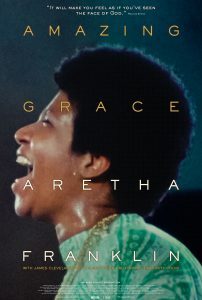

The post This Week in Movies with Meaning appeared first on Brent Marchant.
April 16, 2019
‘The Best of Enemies’ chronicles the cause of change
“The Best of Enemies” (2019). Cast: Taraji P. Henson, Sam Rockwell, Babou Ceesay, Nick Searcy, Wes Bentley, Anne Heche, Bruce McGill, John Gallagher Jr., Nicholas Logan, Gilbert Glenn Brown, Caitlin Mehner, Mckenzie Applegate, Nadej Bailey, Kevin Iannucci, Charles A. Black, Dolan Wilson, Tim Ware, Ned Vaughn. Director: Robin Bissell. Screenplay: Robin Bissell. Book: Osha Gray Davidson, The Best of Enemies: Race and Redemption in the New South. Web site. Trailer.
Many of us dislike change, but sometimes it’s positively essential, no matter how much we may dread it. However, if we approach it with an open mind, a willingness to examine why we resist it and a spirit of cooperation to see the process through, making alterations and adjustments need not be as daunting as we believe it to be. Such was the case for a group of seemingly immovable citizens who wrestled with this question in the inspiring new fact-based drama, “The Best of Enemies.”
Even though 1971 might not seem like long ago to those of us of a certain age, it was very much a different time. This was especially true in some parts of the country and among particular constituencies, circumstances clearly reflected through their spokespeople.
Consider activist Ann Atwater (Taraji P. Henson). The feisty, highly passionate, always-outspoken community leader was someone not to be messed with. She never hesitated to make her opinion known, especially when it came to supporting the rights and well-being of her African-American constituents in the highly segregated city of Durham, North Carolina. She fought hard for her peers, sometimes even chastising her kindreds if they weren’t willing to work as hard as she did when it came to seeking justice and fair treatment.
Of course, Atwater wasn’t alone. The same approach she brought to the table could be said of C.P. Ellis (Sam Rockwell), the leader of the local Ku Klux Klan chapter. Ellis never tried to conceal his prejudicial attitudes, doing all he could to further the cause of segregation and promote the aims of White supremacists. Not only did he never hesitate to intimidate members of the Black community; he also took steps to bring his fellow Caucasians “into line” if they openly showed sympathy or support for minorities. He also had ample support for his efforts, such as the quiet backing of influential businesspeople and politicians, such as city councilman Carvie Oldham (Bruce McGill).
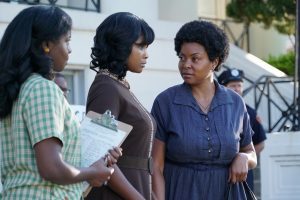
Community activist Ann Atwater (Taraji P. Henson, right) fights hard for her constituents in a segregated community in 1971 in the new fact-based drama, “The Best of Enemies.” Photo by Annette Brown, courtesy of STXfilms.
It’s hard to imagine two individuals who were more diametrically opposed to one another. So it’s almost impossible to fathom how they could have been drawn together to work out an issue they had in common.
The trigger for this unlikely collaboration was a fire at a predominantly African-American grade school. When the flames destroyed a substantial portion of the building, the students were displaced and in need of a new educational facility. Atwater and her followers supported a proposal to transfer the affected students to other, predominantly White schools while their structure was being rebuilt. But no sooner was the issue raised when it met with abundant vocal opposition from Ellis and his constituents. And, when the proposal was brought before the city council, it was summarily defeated.
However, when word of the proposal’s defeat reached the NAACP, the organization contacted Atwater, urging the filing of a lawsuit. The case ended up on the docket of Judge Leslie Hallford (Tim Ware), who wanted to do whatever he could to avoid having to try the case. After consulting Wilbur Hobby (Ned Vaughn), counsel to the court, the judge decided to pursue his attorney’s recommendation – calling for the formation of a charrette, an intensive, citizen-based planning session in which community members come together to work out a solution for the problem at hand, one that’s subsequently submitted to officials for review and possible ratification. Hobby then contacted Bill Riddick (Babou Ceesay), a facilitator experienced at organizing such programs, to see if he would be interested in conducting a charrette in Durham, an offer he quickly accepted.
Upon Riddick’s arrival in Durham, he assessed the situation and met with potential key players. The facilitator wanted chairpersons for the charrette who would be most representative of, and most zealous in advocating for, their respective communities. Given that this was a racially divided issue, he believed that meant finding suitable spokespersons for Black and White constituencies, namely, Atwater and Ellis.
Needless to say, the representative candidates were reluctant to even be in one another’s company, let alone work together. However, thanks to Riddick’s eminently convincing persuasiveness, he was able to bring the unlikely duo together to lead the charrette. Thus began a contentious yet transcendent process through which diehard combatants came together to reach resolution, a journey filled with tension, revelation and transformation.

C.P. Ellis (Sam Rockwell, center), leader of the local Ku Klux Klan chapter, does all he can to promote the cause of segregation in Durham, North Carolina in 1971 as seen in the new fact-based drama, “The Best of Enemies.” Photo by Annette Brown, courtesy of STXfilms.
Confronting the unknown can be a scary prospect, no matter how much we might try to put up a brave front. But, when the apprehension is stripped away, in nearly every case like this, the fear comes from a lack of knowledge, a failure or inability to understand what makes others different from us. This can create a major source of discomfort, one that often is perpetuated and strengthened through our beliefs. And those beliefs, in turn, make that discomfort into a reality, an outcome of the conscious creation process, the philosophy that maintains we draw upon these metaphysical building blocks to construct the existence we experience.
However, once we understand this, it should also be apparent to us that such manifestations are made – and are equally capable of being unmade, transformed into different configurations, including those that seem more familiar and don’t prompt the feelings of anxiety that can become cemented in our consciousness and, subsequently, in the reality before us.
Knowing that, then, we’re never locked into an intractable, unchangeable situation unless we specifically choose to be. Intentionally taking steps to learn about what distresses us can thus open us up to new possibilities, ideas we may have never previously considered due to belief blockages that have kept us from doing so.
This is precisely what happened among Blacks and Whites in Durham, especially in the lives of the two protagonists. Ellis came to see that the Black community was made up of human beings, in many ways just like the White community. And Atwater gradually realized that Ellis was not the devil incarnate, that her adversary had traits that made him just as human as those in her community. It took some time for these realizations to fall into place, but, by spending time working together and seeing one another up close, an understanding took root that subsequently changed the beliefs – and the reality – that each of Ellis and Atwater experienced.
This exercise in overcoming limitations and breaking down barriers is a primary objective of the conscious creation process. It’s reflective of its principal notion that we’re all in a constant state of becoming. What Riddick, Atwater and Ellis were able to achieve shows how radical change, no matter how outlandish it may initially seem, is indeed entirely possible, as long as we leave ourselves open to the possibility, something that begins with our beliefs.
For this to work, there are a number of other considerations that need to come into play. For instance, personal integrity is crucial, for it taps directly into the genuineness of one’s beliefs. If we’re to attain optimum results with our creations, we must make sure that we’re being scrupulously honest with ourselves when it comes to their underlying cornerstones. This became a critical issue for two White representatives of the charrette’s senate (John Gallagher Jr., Caitlin Mehner), the body of community members who actually voted on the citizen proposals put before them. They had to run their beliefs through their personal integrity filters when they were intimidated by Klan members and public officials who wanted them to vote down proposals favorable to the Black community. (Being true to oneself when it comes to balancing the needs of the public and those of the individual apparently can be challenging, especially when one’s personal safety and well-being are on the line.)
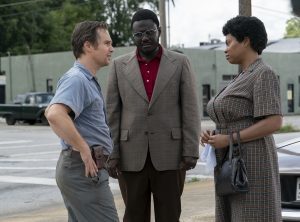
Community activist Ann Atwater (Taraji P. Henson, right) and Ku Klux Klan leader C.P. Ellis (Sam Rockwell, left) are brought together by facilitator Bill Riddick (Babou Ceesay, center) to resolve common issues in the new fact-based historical drama, “The Best of Enemies.” Photo by Annette Brown, courtesy of STXfilms.
This is another instance where the importance of overcoming those aforementioned fears is paramount. If we allow our fear-based beliefs to hold sway, we’ll never make any progress, for they undercut any efforts we initiate to make change. Admittedly, this may be difficult, but it’s essential to avoid stagnation or widening conflict.
It’s interesting to note how the process of change can take on a life of its own once it starts to be implemented. For example, in this case, this process began with finding a school for the students displaced by the fire. But, once the charrette participants started examining the students’ circumstances, they discovered there were more problems than finding a new place for them to attend classes. They learned that the students in the Black school were lagging behind their White counterparts due to such problems as using outdated textbooks and following inadequate curricula. Once revealed, these issues became fodder for other shortcomings to be addressed and corrected through the charrette’s deliberations.
This thus raises an intriguing question about why the fire may have happened: Was it simply due to some unforeseen combustible issue? Or was it a metaphorical catalyst to start the ball rolling where these issues were concerned? After all, would they have come up for discussion were it not for the fire that helped reveal and raise these matters in the first place? Indeed, had the fire not occurred, these problems may have persisted much longer without resolution.
Scenarios such as this often tend to extend to issues that go beyond simply what’s most at hand. They encourage us to dig deeper, to take more probing looks at what we’re creating and why, including the manifesting beliefs that underlie whatever results. This can be quite revelatory and transformative, leading to all manner of previously unconceived possibilities, such as the fact that, as unlikely as it may seem, Atwater and Ellis became life-long friends in the wake of their charrette experience. Now that’s change.

Despite a general tendency toward following formula and overstaying its welcome, this tale about an improbable alliance that arises from worlds apart partners shares messages that we can’t seem to get enough of these days. The fine performances of Henson and Rockwell give life to a story that starts out small and swells to larger issues that we can all benefit from learning about. This is due in part to the picture’s refreshingly balanced screenplay, which doesn’t hesitate to show the negative side of a likable character and the positive side of one generally seen as despicable. Only by getting a closer look at such questions will we be able to get past the prejudices and associated beliefs that hinder our pursuit of new opportunities aimed at benefiting everyone.
A word of note is in order here with regard to what many critics have been saying about this film. Many have called it simplistic in its approach, condescendingly writing that it covers trite, stale territory that’s been examined many times before and that we should all know by now. In doing so, they have unfairly bashed this offering in much the same way they did with recent Oscar winner “Green Book” (2018). And, quite frankly, I find such patronizing responses appalling.
As indicated above, there are aspects of this film that could have been handled better. On balance, though, this picture, like “Green Book,” is competently made and makes its case sincerely without becoming schmaltzy, simplistic or dogmatic. Those who have said otherwise are certainly entitled to their opinion, but, when their comments are as unduly smug, cynical and snide as many of them have been, I have to wonder whether they’re trying to present legitimate film criticism or to show off how smarmy and supposedly sophisticated they and their writing are.
Meaningful change can indeed be hard to come by. It takes work, both in our actions and in the underlying beliefs that give rise to them. In an age where we’re still being tested on these fronts, we must remain mindful of the challenges that remain at hand, including those that many of us (erroneously) believe have disappeared. Fortunately, we have examples like those illustrated in this film to help show us the way. Those who think we can’t learn anything from the past are sorely mistaken, for, if it was possible to institute such broad reform at a time when circumstances were considerably more difficult than they are today, then what excuse do we have now?
Copyright © 2019, by Brent Marchant. All rights reserved.
The post ‘The Best of Enemies’ chronicles the cause of change appeared first on Brent Marchant.
April 15, 2019
Check out The Cinema Scribe
Tune in for the latest Cinema Scribe segment on Bring Me 2 Life Radio, today, April 16, at 2 pm ET, available by clicking here. And, if you don’t hear it live, catch it later on demand!


The post Check out The Cinema Scribe appeared first on Brent Marchant.
April 3, 2019
‘Neurotic Quest for Serenity’ chronicles the search for peace of mind, personal power
“Neurotic Quest for Serenity” (“Transfornada Obsessiva Compulsiva”) (2018). Cast: Tatá Werneck, Vera Holtz, Bruno Gagliasso, Luis Lobianco, Daniel Furlan, Pedro Wagner, Mário Gomes, Patricya Travassos, Ingríd Guimarães, Luciana Paes. Directors: Paulinho Caruso and Teodoro Poppovic. Screenplay: Paulinho Caruso and Teodoro Poppovic, with Pedro Aguilera, Tatá Werneck, Mauricio Bouzon and Tainá Muhringer. Source Collaborators: Daniel Duncan, Gustavo Suzuki and Hell Ravani. Web site. Trailer.
Peace of mind can be elusive, especially when we feel overwhelmed by everything happening around us – or to us. As the pressure mounts, we may begin to feel ourselves fraying at the edges as the stress creeps deeper and deeper into our being. And we can only tolerate these circumstances for so long before they finally take a toll on us, leading to anxiety or weariness and possibly even a meltdown. So it is for an overburdened actress seeking to keep it all together in the manic Brazilian farce, “Neurotic Quest for Serenity” (“Transfornada Obsessiva Compulsiva”), now available on video on demand.
Kika K (Tatá Werneck) feels like she’s coming apart at the seams. The popular Brazilian telenovela star tries to manage a full plate of commitments, a challenge made difficult by her hyper-aggressive agent, Carol (Vera Holtz), who constantly books her client for acting and publicity gigs, sometimes without informing her until the last minute. But, if that weren’t bad enough, Kika also suffers from OCD, as well as an overactive imagination and vivid dreams, all of which have started sneaking their way into her perceptions of everyday reality.
Kika realizes she must get a handle on her life, but she has no idea how. It’s a frustrating conundrum made comically ironic by Carol’s surprise announcement that she’s arranged for her client to participate in a promotional tour for a self-help book that bears her name, a title of which Kika was completely unaware, penned by an enigmatic ghost writer (Pedro Wagner). In addition to all her other responsibilities, Kika must now prepare for book signings and media appearances, such as a guest spot on a TV talk show featuring popular celebrity host Ana Juliana (Luciana Paes), to plug a book about which she knows virtually nothing despite the presence of her name on the cover.
To complicate matters, Kika must also contend with other challenges, such as the constant advances of her oversexed co-star, Caio Astro (Bruno Gagliasso), the incessant stalking of an obsessed, portly fan, Felipão (Luis Lobianco), and the conniving sniping and machinations of a rival actress, Ingrid (Ingrid Guimarães). Considering all this, it’s a wonder she’s been able to hold things together as well as she has for as long as she has.
Things reach a tipping point, however, when Kika loses it at a book signing. Fortunately, a milquetoast-esque bookstore employee, Vladimir (Daniel Furlan), comes to her rescue, a kindly gesture that she’s not especially appreciative of at first. But, once she starts coming to her senses, Kika realizes she’s found an unlikely knight in shining armor, one who sets her on the path of sorting out her life. Of course, given all the challenges she’s been facing, the road to serenity going forward continues to be riddled with potholes that make her journey an odyssey full of adventure and lunacy.

Telenovela star Kika K (Tatá Werneck, left) seeks solace from the craziness in her life with introverted bookstore employee Vladimir (Daniel Furlan, right) in the Brazilian screwball comedy, “Neurotic Quest for Serenity” (“Transfornada Obsessiva Compulsiva”).
Will Kika achieve the tranquility she seeks? That remains to be seen. But, if it’s to happen, she needs to make some changes to reshape her reality, all of which start with her.
So how did Kika’s life become so topsy-turvy in the first place? Strange as it may sound to some, she brought it upon herself through the conscious creation process, the philosophy that maintains we manifest the reality we experience through the power of our thoughts, beliefs and intents. But, one might ask, why would anyone purposely create an existence like the one Kika experiences?
As I’ve written in the past, why we create what we create is up to each of us; our reasons are our own, and they’re really nobody’s business to question. We can speculate about what’s involved, though, in most cases, our experiences are generally related to learning specific life lessons, and Kika is no exception.
When the foregoing is taken into consideration, it’s apparent that much of what Kika is going through is related to the management of her personal power. In creating the career she’s built for herself, she’s obviously been quite successful in manifesting her professional accomplishments. She’s given herself the attributes needed to attain that, such as acting talent and physical beauty, and those qualities have placed her in great demand (witness the advances of her co-star and her stalker, the many producers eager to hire her, and the jealous glaring of her rival).
Based on this, Kika has apparently done quite an effective job at managing her power-related beliefs. But what accounts for the rest of her life? She’s so put upon by the other influences in her life that she’s overcome by them and in danger of sinking fast. This comes from giving away one’s power, a commodity that Kika desperately needs to retrieve if she doesn’t want to be consumed by these vampiric elements in her life.
Of course, Kika won’t know what it’s like to get her power back unless she creates the opportunity to engage in such an experience (hence the mayhem that surrounds her). She also benefits from the assistance she receives from having a grounding influence in her life, something that accounts for Vladimir’s presence. Even though he has challenges of his own to contend with, he helps Kika get her groove back.
In retrieving our personal power, a key component of this process is deciding on, and then affirming, what we want for ourselves. That might sound simple enough, but it must become rooted in our thoughts, beliefs and intents. Merely relegating it to a passing notion, unfortunately, places it in the realm of wishful thinking, a weaker and largely uncommitted expression of this idea, one that’s unlikely to become grounded and subsequently materialize.
This is an area in which Kika needs to do some work, particularly where her beliefs are concerned. Part of the reason why she lacks the serenity she seeks is that she’s personally unsettled about what she really wants. This would account for her overactive imagination, vivid dreams and OCD, all of which reflect her scattered mindset and rampant indecisiveness, as well as her inability to settle on what she most wants to pursue. Whittling down her options and eliminating the possibilities she sees as unrealistic are essential, but certainty in this regard is unlikely unless she’s willing to make an earnest effort.

This insanely hilarious search for the meaning of life plays like a cross between “Hector and the Search for Happiness” (2014) and “Welcome to Me” (2014). This screwball comedy moves along at a break-neck pace from the outset and never lets up with its outrageous, off-the-wall humor and bizarre, colorful visuals. This directorial feature film debut from Paulinho Caruso and Teodoro Poppovic won’t appeal to everyone, but, for those who like their comedies with an edge, this one is definitely for you. What a wild ride it is!
Life can be funny, but sometimes it’s no laughing matter. Finding the right balance between the two makes for a happy (and fun-filled) medium. That’s perhaps one way of looking at each of our personal quests for serenity. But let’s hope the search includes beliefs that are amendable and manageable – and by no means neurotic.
Copyright © 2018-19, by Brent Marchant. All rights reserved.
The post ‘Neurotic Quest for Serenity’ chronicles the search for peace of mind, personal power appeared first on Brent Marchant.
April 1, 2019
‘Little Gandhi’ inspires the visionary in each of us
“Little Gandhi” (2016). Cast: Interview Footage: Robert Ford, Najlaa Alsheikh, Osama Abu Zayd, Motaz Morad, Ghiath Shurbaji, Muhammad Shihadeh, Shafeek Abdulaziz, Muhanad Abu Alzen, Rana, Hassan Abo-Kinan, Mohammed Namous, Radwan Ziadeh, Ahmad Shurbaji. Archive Footage: John Kerry, David Cameron, Ghiath Matar, Yahya Shurbaji. Director: Sam Kadi. Screenplay: Sam Kadi. Web site. Trailer.
It’s been said that one catches more flies with honey than with dung. While that may be true in many circumstances, it can be a tricky practice in political circles. If nothing else, though, it can make a statement, regardless of whether its objectives are met. So it was with an unconventional but fearless nonviolent activist fighting for change in his beleaguered homeland, the subject of the compelling new documentary DVD release, “Little Gandhi.”
Peaceful protest has often inspired activists to seek change in political regimes in dire need of it. In 2011, with the Arab Spring movement sweeping across the Middle East from Tunisia to Libya to Egypt, the initiative soon made its way to Syria, home of the Bashar al-Asaad regime, one of the world’s most brutal dictatorships. Continuing horrific practices initiated by his father as far back as the 1980s, Asaad ruled with unquestioned authority, relentlessly doling out punishment without regard for the welfare of the nation’s citizens. Such atrocities, combined with a corruption-riddled administration, signaled that this was a situation long ripe for change.
Under conditions like this, there was a natural tendency among many activists to want to lash out in anger. But one of those who stepped to the fore to encourage a different path was Ghiath Matar. Rather than combating the Syrian government forces ordered to put down opposition, Matar suggested a different path – making their voices heard but treating the troops with kindness and courtesy, offering them flowers and bottled water as gestures of goodwill.
Why such an unconventional strategy? Matar believed that distributing flowers and water would defuse the situation before it escalated out of control. According to his colleagues, Matar saw flowers as a symbol of life, something he wanted to affirm through his protests and convey to his opponents. He was convinced that such gestures of peace would help undermine the plans of those ready to engage in violence. To Matar, giving flowers and water to the security forces was a way of showing them that the protestors did not believe the troops were the enemy, that they were all Syrian brothers and that (one would hope) brothers would not fire on brothers.
When protests in Matar’s home town of Daraya began in March 2011, the activists followed through on their plan. The flowers were seen as kind offerings, and the bottled water was much appreciated among soldiers on duty in the desert heat. These gestures and the troops’ responses took authorities by surprise, so much so that they scrambled to come up with a strategy to regain control over their forces. They even went so far as to try and convince the soldiers that the activists had poisoned the water, a ruse that fell apart when the protestors opened the bottles and began drinking from them. Matar’s plan proved successful, revealing him to be someone wise far beyond his 26 years.
Matar’s initiatives were not without precedent. Nonviolent protest was a standard practice in the 1960s American civil rights movement led by Dr. Martin Luther King Jr. and his followers. And the distribution of flowers was a favorite placating tactic employed by Vietnam Era protestors, who frequently dispensed blooms to National Guard troops called upon to keep the peace at antiwar rallies. But measures such as these were perhaps most readily associated with Indian peacemaker Mohandas Gandhi, who made use of them in helping his nation earn independence from the British Empire in the 1940s. In fact, it was his legendary efforts that inspired the nickname attributed to Matar, Little Gandhi.

With the assistance of such fellow protestors as Najlaa Alsheikh, Osama Abu Zayd, Motaz Morad, Ghiath Shurbaji, Muhammad Shihadeh, Shafeek Abdulaziz, Muhanad Abu Alzen, Rana, Mohammed Namous and Hassan Abo-Kinan, Matar quickly developed a formidable peaceful opposition network. His hope was that its efforts would raise awareness for the cause, one aimed at ousting Asaad without the nation erupting in what he believed could be a bloody civil war. He and his followers were treading on shaky ground, but they persisted in their efforts nevertheless. They were convinced that now was the time for a regime change; they believed they had the momentum on their side as the Arab Spring movement made considerable headway throughout the region, leading to such huge accomplishments as the toppling of long-time Egyptian president Hosni Mubarek, a leader whose corrupt administration had held power for decades.
Matar’s efforts didn’t go unnoticed by authorities, however. He was constantly threatened by officials, forcing him to stay mobile, often having to seek refuge in farmland hideouts in the areas surrounding Daraya. This wasn’t easy for a newlywed husband and father-to-be, but he did what it took to stay out of sight while planning his next protest. However, when Matar and fellow protestor Yahya Shurbaji were arrested, circumstances took a drastic turn.
Not long after his capture, Matar was tortured and killed. International outrage erupted when word of his death spread far and wide. Foreign leaders condemned this horrendous act, with the ambassadors of many Western nations, including U.S. Ambassador Robert Ford, defiantly attending his funeral.
Unfortunately, with Matar’s death, what he feared the most came to pass – a protracted and bloody civil war, one that left his home town in shambles. In fact, as the film sadly shows, the fighting continued years after the conflict began. This becomes apparent during war zone interviews with activists Motaz Morad and Muhammed Shihadeh, whose comments are frequently interrupted by the sound of gunfire in the background.
What’s more, nearly all of the activists interviewed in the film have been forced to flee Syria. Even though they still actively support the pro-democracy movement, most now live in exile, primarily in Turkey. They are among the approximately 5 million refugees who have fled their homeland in search of safe haven outside their nation’s boundaries.
As for Matar, an organized effort to destroy all records of his efforts – and even of his existence – has been implemented by Syrian officials to squelch any inspiration his memory might evoke. Even photographs of the activist are hard to come by these days. But, despite this purging and Matar’s tragic death, the ideas he inspired can’t be killed. The spirit of Little Gandhi lives on.
Bringing about the kinds of changes that Syrian activists have sought is quite an undertaking. It requires considerable effort, not only for the activities in which they engage, but also in the ideas they devise to make those reforms a reality. They must sincerely believe in what they seek to accomplish, materializing their dreams through the conscious creation process, the philosophy that maintains we manifest the existence we experience through the power of our thoughts, beliefs and intents.
For Matar and his followers, their belief in seeking change is firmly rooted in the faith of their convictions. They knew that reform had to come. For instance, the relentless surveillance of everyday citizens was so pervasive (and intolerable) that most Syrians had come to believe, as activist Mohammed Namous put it, “The walls have ears.” The need for reform had become so plainly apparent that some protestors, like Ghiath Shurbaji, said, without hesitation, “We must change our reality.” Spoken like a true conscious creator.
Many of the activists began cutting their teeth on this subject in 2003, when they made their initial forays into invoking reform. This preliminary exploration helped prime their enthusiasm for what would follow years later, laying a foundation for the grander plans that were to come. It also helped to promote a spirit of cooperation, the kind of unity needed to make acts of co-creation work.
On top of that, though, the initiative required thinking outside the box, overcoming the limitations of conventional thought that might otherwise hold them back or thwart their efforts. This is where Matar’s nonviolent protest strategy came into play. His plan to engage in gestures of kindness and courtesy rather than aggression and hostility kept the rallies from turning violent and derailing the groundswell of support that the campaign was building.
Admittedly, Matar and his colleagues were taking a big chance in implementing their plan. Considering the brutality of the Asaad regime, they could have been made to vanish in an instant. But change seldom results from playing it safe, and Matar’s example lit a fire amongst his peers. He inspired confidence and courage among the activists, helping them to allay the fears that might have otherwise stopped them in their tracks – and keeping the campaign from ever getting off the ground.
Given what happened to Matar, some might question the wisdom of his efforts. However, where would we be as individuals or as a species if we didn’t take chances, following the impulses of our beliefs to see where they lead us? Perhaps visionaries like Matar are the seed planters, invoking ideas that they don’t fulfill personally but who build the platforms on which their ultimate manifestations are constructed. They become the legends who inspire generations of followers who see through on his vision, a testament to his dream and a tribute to the man who birthed the notion into being. And there’s certainly something to be said for that.
This stirring profile of an enlightened visionary leaves quite an impression on the viewer. As Syria’s first-ever entry in the Academy Awards’ best foreign language film category, “Little Gandhi” presents a gripping collection of archive footage from the protests and the civil war, as well as enlightening interviews from activists, authorities and experts, most of whom witnessed the events firsthand. Director Sam Kadi has put together a fine tribute to its heroic subject, one that is sure to motivate those seeking to bring about change where it’s needed, no matter how daunting the conditions might be.
The planet could use more individuals like Ghiath Matar, especially now, and not just in Syria. Let us hope there are impressionable initiates out there who are willing to follow in his footsteps to bring all of us what we crave – and deserve. Indeed, the time has come for all of the other Little Gandhis of the world to step forward and take their rightful place in destiny.
Copyright © 2019, by Brent Marchant. All rights reserved.
The post ‘Little Gandhi’ inspires the visionary in each of us appeared first on Brent Marchant.
March 28, 2019
‘Us’ forces us to take a look at ourselves
“Us” (2019). Cast: Lupita Nyong’o, Winston Duke, Shahadi Wright Joseph, Evan Alex, Elisabeth Moss, Tim Heidecker, Cali Sheldon, Noelle Sheldon, Yahya Abdul-Mateen II, Anna Diop, Madison Curry, Ashley Mckoy, Napiera Groves, Alan Frazier. Director: Jordan Peele. Screenplay: Jordan Peele. Web site. Trailer.
Have you ever thought what it might be like to meet yourself? How we see ourselves can be an eye-opening experience, especially if what we observe doesn’t match our expectations. What we encounter could be significantly different from what we believe about our being, our attitudes and our behavior. But, on closer inspection, we may be surprised to see that it’s exactly who we are at our core, a scenario that gives us much to assess, some of which could be at odds with who we’d like to think we are. Such is the case for a seemingly average American family in the revelatory new smart horror release, “Us.”

It’s summertime, and the Wilson family is ready for their annual trip to their vacation home near Santa Cruz, California. Parents Adelaide (Lupita Nyong’o) and Gabe (Winston Duke), along with their children, Zora (Shahadi Wright Joseph) and Jason (Evan Alex), look forward to their getaway, but there’s an undercurrent of uneasiness underlying the trip, especially for Adelaide. Gabe does his best to allay his wife’s anxiety, but she quietly continues to harbor her apprehension.
Adelaide is particularly concerned about the family’s planned daytrip to the beach. It’s a popular tourist destination with an adjacent boardwalk and amusement park. With so much to do, it’s the kind of place that should make for a good time, but Adelaide is full of trepidation about the outing because of an experience that happened to her there when she was a child. It was a traumatic incident that she’s kept mum about all these years, but, when Gabe presses her about her hesitation, she finally opens up.
On a warm summer night in 1986, a young Adelaide (Madison Curry) visited the amusement park with her parents, Russel (Yahya Abdul-Mateen II) and Rayne (Anna Diop). At one point while her parents weren’t looking, the youngster inexplicably wandered off, walking into a funhouse with a Native American vision quest theme, one that challenges visitors to “discover yourself.” As she made her way through the structure’s dark and mysterious corridors, she came upon the kinds of elements typically found in these attractions, such as animated figures that pop out of the walls. Needless to say, these features startled the young visitor, but Adelaide’s biggest frights were yet to come.

When faced with an unexpected terrifying situation in an amusement park funhouse, young Adelaide Wilson (Madison Curry) reacts in fright to what she sees in director Jordan Peele’s “Us.” Photo courtesy of Universal Pictures.
While walking through the funhouse’s hall of mirrors, Adelaide saw something in the looking glass that took her by surprise – an image of what appeared to be herself with her back turned toward her. But then, quite unexpectedly, the figure turned to face her with bulging eyes and a sinister grin beaming from ear to ear.
Adelaide was so stunned by what she saw that she withdrew and stopped talking. Her parents took her to a therapist (Napiera Groves), hoping that counseling would draw out what happened and set her on a course of recovery. And, thanks to her development of an interest in dancing, an adolescent Adelaide (Ashley Mckoy) emerged from her isolation. But, even with the passage of time, the experience still haunts the now-adult Adelaide all these years later.
Gabe is stunned that Adelaide has kept everything locked up inside for so long, but, having now shared the experience, she seems moderately relieved. Consequently, to keep peace in the family, she agrees to go on the outing despite being on guard the whole time. She’s constantly on the lookout for anything unusual, and she has trouble relaxing, even while spending time in the company of her good friends Kitty (Elisabeth Moss) and Josh (Tim Heidecker) and their two daughters (Cali Sheldon, Noelle Sheldon). But, when the time comes to leave, she’s only too happy to pack up and go home.

What should be an enjoyable summertime vacation turns contentious when the Wilson family (from left, Lupita Nyong’o, Evan Alex, Shahadi Wright Joseph, Winston Duke) receives a visit from unexpected “guests” in director Jordan Peele’s latest offering, “Us.” Photo by Claudette Barius, courtesy of Universal Pictures.
Once back at the vacation house, though, things take a rather weird turn. First the power goes out. And then, lurking in the dark, Adelaide notices a family of four standing in the driveway, one whose members bear an uncanny resemblance to the Wilsons. They stand silently arm in arm dressed in red jumpsuits, each holding what appears to be some kind of pointed golden implement.
Gabe doesn’t think much of it and makes a friendly attempt to see what they want. But, when he finds out these apparent doppelgangers are anything but cordial, the situation turns contentious. The “copies” of Adelaide, Gabe, Zora and Jason, who respectively call themselves Red, Abraham, Umbrae and Pluto, break into the house and begin terrorizing the inhabitants, all for no apparent reason and without making any specific demands – that is, until Red begins to speak, informing her hostages who they are and what they want.

The unexpected appearance of a creepy-looking family (from left, Evan Alex, Winston Duke, Lupita Nyong’o, Shahadi Wright Joseph) places a damper on a summer vacation in the superb new smart horror release, “Us.” Photo by Claudette Barius, courtesy of Universal Pictures.
To say more would reveal too much, but suffice it to say that the Wilsons are not the only ones being confronted by their doubles. Everyone, it seems, is being met by their alternate selves. These duplicate beings bring a reign of terror to the world, emerging en masse from what appear to be subterranean tunnels whose existence was virtually unknown by the public at large. Most violently attack their surface world counterparts, while those who don’t join in the barbarism hold hands to form a human chain across the landscape (a gesture eerily reminiscent of the Hands Across America initiative organized to raise awareness about the homeless in the summer of 1986, the time when Adelaide had her traumatic amusement park experience).
But to what end is all of this transpiring? That’s what the Wilsons – and the rest of the world – are about to find out. And the answer will prove quite surprising, to both those on and off the screen.
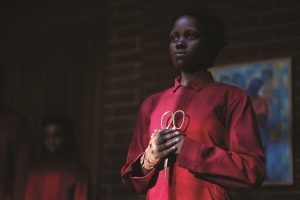
“Red” (Lupita Nyong’o), the enigmatic doppelganger of a middle-aged housewife, makes life hell for her counterpart and her family in director Jordan Peele’s “Us.” Photo by Claudette Barius, courtesy of Universal Pictures.
“Us” is a film that raises almost as many questions as it answers. Director Jordan Peele has presented viewers with an intriguing cinematic puzzle, one that’s densely packed with ideas, themes and images and, consequently, is open to interpretation on multiple levels, all equally valid and none contradictory of one another. The key question in this is “What do you believe?”
There’s quite an irony in that, given that the same inquiry is central to understanding the conscious creation process, the philosophy that maintains we manifest the reality we experience through the power of our thoughts, beliefs and intents. In this case, though, the filmmaker is asking us to do as much work in that vein as he’s putting his characters through. In that sense, then, we’re not just being offered a celluloid example of the philosophy at work; we’re also being tasked with engaging in an exercise that allows us to see firsthand how it functions, with each of us given an opportunity to create a cinematic experience of our own, one based on the beliefs we hold about the material being presented to us. And, since conscious creation essentially maintains that we each create our own reality, we’re each going to do just that where this picture is concerned in terms of what we see, what we think about it and what we ultimately experience, all driven by our beliefs.
For the record, we actually do that when we see any movie (or actively engage in participating in any aspect of our existence, for that matter), but we usually take the circumstances and outcomes in those situations for granted, paying little attention to how they arise. Here, though, director Peele places that notion inescapably in front of us, impelling us to participate – consciously – in this exercise in reality creation. In that regard, we’re truly doing more than just watching a movie; we’re being given a metaphysical tutorial of sorts, one that, in the end, is enlightening, entertaining, thought-provoking and a hell of a lot of fun.

The unexpected arrival of mysterious visitors causes stress for middle-aged housewife Adelaide Wilson (Lupita Nyong’o, right) and her husband, Gabe (Winston Duke, left), in “Us.” Photo by Claudette Barius, courtesy of Universal Pictures.
While many viewers are likely to have similar takes on what they see, there will no doubt be instances where individual audience members come up with interpretations all their own. But that’s okay, considering the ample fodder that the filmmaker gives us to work with (not to mention the fact that we already do the same when it comes to our experiences in other life contexts). So what I offer here are my thoughts on what this picture is saying from a conscious creation perspective. And, in doing so, as I noted above, I’ll make an especially concerted effort to share my views without revealing any spoilers in the process.
The idea of a doppelganger is an intriguing one, a notion that has found its way into an array of subjects, ranging from mysticism and mythology to contemporary psychology. Given this level of pervasiveness, it would seem there must be something to it. But how many of us pay any real attention to it? We tend to ignore the concept until we find ourselves staring it in the face. Then what?
As a general rule, when we come face to face with a manifestation of our personal selves, our first question is usually to ask why it has materialized. What does it want? Is it trying to tell us something? And why now? Those are the questions on the minds of Adelaide and her family when their doubles first appear, and they find the experience frustrating due to the lack of ready answers. I think it’s a safe bet many of us would have comparable reactions. But, where the Wilsons are concerned, this becomes a bigger problem when their unexpected visitors start lashing out at them in violent and hostile ways.

Siblings Jason (Evan Alex, left) and Zora (Shahadi Wright Joseph, right) are forced to grow up a lot faster than they had probably imagined when faced with tremendous horrors in the gripping new offering, “Us.” Photo by Claudette Barius, courtesy of Universal Pictures.
Considering where the doubles are said to have originated, though, the answers might come a little more easily. Having emerged from a complex of underground tunnels into the light of the world aboveground, the doppelgangers are in many ways symbolic of our shadow selves, that little-seen part of our being that resides within the darkness inside us. It’s a portion of our being that’s largely ignored, if not summarily disparaged, looked upon as inherently inferior, perhaps even evil. It’s something most of us would much more readily disavow than acknowledge.
However, as much as we might try to deny this portion of our self, it’s nevertheless part of who we are. And, because of this, imagine how we would feel if we were to walk in its shoes. The lack of recognition and blanket rejection must be utterly unbearable. Given that, then, is it any wonder that the shadow self might eventually rise up and rebel, demanding to share in the same blessings we have come to enjoy from living life in the light? Of course, having spent its entire existence in the murky depths, is it also any wonder that our shadow might not know how to properly (i.e., civilly) seek equitable treatment? That would explain the barbarous behavior, now wouldn’t it?
If it’s possible to envision how this would work for an individual, imagine the same for a collective of similarly situated beings. This would account for the film’s mass uprising. But, speaking symbolically once again, this is an allegory for the outcasts of contemporary society – women, minorities, immigrants, the economically disadvantaged – everyone who has been denied the opportunity the revel in the bounty that comes from the abundance afforded by “life on the surface,” those who reside above those literally and figuratively relegated to the underworld.

Middle-aged housewife Adelaide Wilson (Lupita Nyong’o) fights back when confronted with extraordinary circumstances in the new smart horror release, “Us.” Photo by Claudette Barius, courtesy of Universal Pictures.
What’s even more telling in this scenario is the shoddy treatment the surface dwellers afford their below-ground counterparts. Those who live in the world below are dismissed, treated as if they don’t exist, a circumstance that can be applied both to our individual selves as well as society as a whole. And, sadly, this is “us,” a realization that makes the picture’s title fittingly chilling in light of its narrative and genre.
Considering that indifferent, condescending attitude – one created by the beliefs of those who hold it – it’s not too difficult to figure out what it would take to get their attention. And those who demand their share of the pie may not be as gracious in seeking it as those living in the light might think they should be (the one-percenters might want to take note of this). But, then, such outcomes are not unexpected when we practice un-conscious creation, an expression of the philosophy that results when we focus exclusively on manifesting what we want with no consideration for the consequences of our efforts, one often fraught with unintended and undesirable side effects. In this case, the resulting situation calls to mind a Biblical passage that’s prominently featured in the film literally, figuratively and symbolically, the text of Jeremiah 11:11: “Therefore thus saith the Lord: ‘Behold, I will bring evil upon them, which they shall not be able to escape; and though they shall cry unto Me, I will not hearken unto them.” Yet another manifestation belief is fulfilled, one as reflective of the notions held by its adherents as anything seen in the funhouse hall of mirrors.
Admittedly, the foregoing is a lot to absorb, but, in actuality, it’s only part of the story. There’s potentially much more one can take away from this film, again, depending on the individual belief-based interpretations discussed earlier. I could say more, but I’d be straying too close to the spoiler territory I endeavor to avoid. So my recommendation is to watch this one for yourself and see what you get out of it. Personally, I can’t wait to screen it again to see what I may have missed the first time.

When middle-aged housewife Adelaide Wilson (Lupita Nyong’o, right) confronts her dubious double, Red (Lupita Nyong’o, left), the encounter quickly turns into a fight for survival in the gripping new smart horror offering, “Us.” Photo by Industrial Light & Magic, courtesy of Universal Pictures.
This richly layered, deftly nuanced smart horror offering tells a tale that gives the audience much to think about upon leaving the theater. Director Peele’s second feature defies “the sophomore jinx” that often plagues filmmakers who fail in their followup efforts after impressive debuts. The picture delivers an expertly crafted allegorical story that’s captivating and insightful, accompanied by great laughs and a few good scares without becoming gratuitous. This is all made possible by the superb performances of its excellent ensemble cast, most notably Nyong’o, who turns in some of her best on-screen work in this offering. And, as you watch it, take nothing for granted; everything has a purpose in the narrative, no matter how seemingly insignificant. As good as his first picture, “Get Out” (2017), was, the filmmaker has taken a quantum leap in his artistry and storytelling skills with this release, an accomplishment that puts him in a class by himself and will likely allow him to write his own ticket from here on out.
When we come face to face with ourselves, we’re forced into confronting what we see. No matter how much we might try to deny or disavow what we witness, though, we can’t realistically do so if we truly want to understand who we are at the center of our being. And, if we dislike what’s there, then we must take an earnest look at how it arose, analyzing and, if needed, changing the thoughts, beliefs and intents that gave life to it. After all, when we come right down to it, that’s us – whether we like it or not.
Copyright © 2019, by Brent Marchant. All rights reserved.
The post ‘Us’ forces us to take a look at ourselves appeared first on Brent Marchant.
Catch Movies with Meaning
Join host Frankie Picasso and me this Thursday, March 28, for the latest edition of Movies with Meaning on The Good Media Network’s Frankiesense & More broadcast. We’ll look at a variety of new releases and share the latest movie news. For the video version, tune in on Facebook Live at 1 pm Eastern by clicking here. And, for the audio-only podcast edition, check out The Good Media Network’s home page by clicking here. Join us for some lively movie chat!


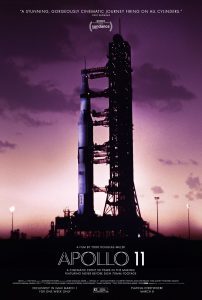
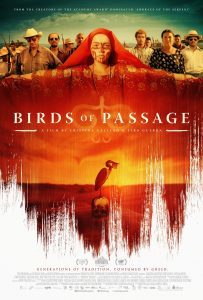


The post Catch Movies with Meaning appeared first on Brent Marchant.
March 25, 2019
‘Smuggling Hendrix’ unleashes the call for freedom, harmony
“Smuggling Hendrix” (2018). Cast: Adam Bousdoukos, Fatih Al, Vicky Papadopoulou, Özgur Karadeniz, Georgia Constantinou, Toni Dimitriou, Marios Stylianou, Andreas Phylactou, Charlambos Charlambou, Pepper. Director: Marios Piperides. Screenplay: Marios Piperides. Web site. Trailer.
What can we learn from our pets? Actually, quite a lot, as long as we’re paying attention. The trick, of course, is looking behind what they’re trying to show us, to see the real meaning behind their actions. But, if we do so, we might reap some tremendous benefits. So it is with a four-legged furry mentor in the charming new comedy, “Smuggling Hendrix.”
On the divided Mediterranean island of Cyprus, where combative Greek and Turkish factions have been living under a somewhat uneasy truce for more than four decades, life can be complicated, even when attempting to accomplish the simplest of tasks. That’s what a shaggy, unemployed musician, Yiannis (Adam Bousdoukos), discovers when his dog, Jimi (Pepper), goes astray. The scruffy pooch, named for legendary guitarist Jimi Hendrix, may be lovable, but he can also be quite mischievous. And, unfortunately, because of the island’s bureaucracy, regulations and long-simmering mistrust among residents, something as seemingly simple as retrieving a lost pet becomes an unbelievably complex, incredibly maddening experience.
This situation is especially frustrating for Yiannis, given that he’s three days away from leaving the island to start a new life in Holland. He’s tired of things never working out, not to mention the daily hassles of living in Nicosia, the country’s divided capital city. So it goes without saying that he doesn’t need these kinds of annoyances as he attempts to wrap up his affairs before departing.
So how does this situation come to pass? While running last-minute errands and walking Jimi, Yiannis unexpectedly encounters a number of people he’s trying to avoid – Kika (Vicky Papadopoulou), his ex-girlfriend with whom he had a difficult breakup; Pambos (Toni Dimitriou), a loan shark from whom he borrowed funds to make an unsuccessful album and who now wants to collect on his debt, backed by the support of his hired muscle, Antonis (Marios Stylianou); and his feisty landlady (Georgia Constantinou), to whom he owes five months’ back rent. He does his best to evade them, hiding out in an antique shop. But, while waiting things out, Jimi breaks free and escapes. The dog starts running the streets, fleeing from Nicosia’s Green-controlled sector to the cordoned off Turkish territory.

Shaggy, unemployed musician Yiannis (Adam Bousdoukos, left) discovers the pettiness of bureaucratic regulations when he tries to bring his retrieved dog, Jimi (Pepper), across the border from Turkish-controlled territories to Greek-controlled lands on the divided island of Cyprus in the endearing new comedy, “Smuggling Hendrix.” Photo courtesy of The Match Factory.
On the surface, Jimi’s little escapade may not seem like a big deal, but getting him back is, because traveling from one sector of the city to another isn’t especially easy. To move between territories, visitors must pass through two checkpoints, one staffed by national authorities and one manned by United Nations peacekeepers. Even though this process generally only requires showing one’s papers, there are other kinds of restrictions involved. Since the Greek-controlled territory of Cyprus belongs to the European Union, anyone returning to lands under EU auspices must abide by the Union’s restrictions. And, since the Turkish-controlled area of Nicosia is part of a self-proclaimed independent state that virtually no one officially recognizes (including EU member states), anyone returning to Union-governed territories must abide by the organization’s various entry protocols, some of which can be rather stringent, as Yiannis soon finds out for himself.
To retrieve Jimi, Yiannis crosses from the island’s Greek sector to the breakaway Turkish Republic of Northern Cyprus. And, miraculously, he finds his beloved canine surprisingly quickly. However, in attempting to return to his homeland, he’s told by authorities that he can’t bring the dog back over the border. Doing so would violate EU quarantine restrictions against the importation of potential biological health hazards from an unrecognized nation. Yiannis pleads his case, noting his impending departure from the island, but to no avail. So now what?
Unwilling to abandon Jimi, Yiannis sets about devising a plan to smuggle his dog back into the Greek-controlled territory, but that proves easier said than done. Thanks to a series of additional incidents, Yiannis’s plans routinely go awry. Along the way, circumstances bring him into contact with Hasan (Fatih Al), a Turkish mechanic who reluctantly agrees to help arrange an expensive, clandestine cross-border passage for Jimi with the aid of a shady drug dealer, Tuberk (Özgur Karadeniz). When that doesn’t work out, Yiannis then seeks to make alternate arrangements that unwittingly draw him into the company of those he’s trying to avoid – Kika, Pambos, Antonis and his landlady, all of whom make his life even more difficult. And, of course, there’s Jimi, whose antics continue to frustrate his owner. Meanwhile, the clock is counting down to Yiannis’s scheduled departure. Will everything work out in time?
To call this situation a comedy of errors would be an understatement. But, at the same time, it also draws attention to a number of more serious matters worthy of profound consideration, particularly the underlying beliefs that brought them into being. As products of the conscious creation process, the philosophy that maintains we manifest the reality we experience through the power of our thoughts, beliefs and intents, these issues ultimately arise from us, making us the ones responsible for their materialization and inherent qualities, including any alterations that are deemed necessary to make them more to our liking.
Most notably this is true where the island’s political situation is concerned. Cyprus is a divided nation, one saddled with self-imposed borders that keep its inhabitants apart from one another, each faction believing it has a right to its lands, rights of self-governance and so forth. Such a separation didn’t arise by osmosis, though; it was created, brought into being by beliefs of those on each side of the barricades. Ironically, though, the Greek and Turkish residents depicted in the film each routinely insist upon the intrinsic brotherhood that binds them, that, in the end, they’re all members of the same human race.
But, if that’s true, then why the borders? Why are the island’s artificial boundaries set up to keep these supposed brothers apart? Lurking behind the superficial proclamations of unity lies an innate mistrust that has spawned and continues to enforce this division.
At the same time, though, everyone in the story seems to love Jimi. They all seem to be able to agree that affection for a pet transcends the social and political boundaries that separate individuals from one another. So, if everyone can agree on that where an animal is concerned, then why can’t they do the same when it comes to their outlooks toward their fellow man? Jimi helps to unite the humans where he’s concerned, setting an example for them to do the same with one another – provided they avail themselves of it.
But, if that’s going to happen, then a belief change is obviously in order, something that may not be as easy to achieve as one might hope. If the parties can’t agree on something as simple as the requirements for bringing a pet across the border, then what hope is there for the feuding factions to come together in peace and harmony? It’s by no means impossible, but the change must begin with the beliefs each side holds. One can only hope Jimi provides them with some inspiration to do so.
For a suitable reconciliation to occur, for each faction to truly come together as the brothers they claim to be, they must join forces in an act of co-creation, one driven by commonly held cooperative beliefs. It’s a point the film drives home repeatedly where the Cypriot political situation is concerned, with Jimi serving as the catalyst for attempting to draw his divided human countrymen together. The misadventures they jointly share reveal the petty ridiculousness driving the circumstances that keep them apart, conditions that both separate man from dog and fellow man from fellow man. Indeed, if we’re all one big human family, this niggling estrangement seems pretty silly in the end – and, ironically, it takes man’s best friend to help show us the errors of our ways and the beliefs behind them.
In addition to the harmony Jimi’s actions promote, he also exemplifies the spirit of individual freedom. His escape embodies the exhilaration of being unleashed, allowed to run free, both literally and figuratively, to pursue what he wants. This is something most of us long to do but often feel we are unable to experience due to the many ties that bind us. Yiannis clearly wishes for this, for example, as evidenced by his desire to be free of the aggravations of life on Cyprus, not to mention his longing to break the chains that tie him to his past. If that’s to happen, though, he must believe in the possibility, an option that just might happen if he follows Jimi’s lead. Good luck to him and all those who desire to cut loose and run like the wind.

This delightful tale about a scruffy pooch showing us the needless difficulty involved in bringing us together as a unified people is funny, touching and heartwarming. Though a little too political at times, the film nevertheless does an excellent job of explaining a contentious situation that hasn’t received much attention in quite some time, while simultaneously casting a bright light on the need to resolve a dispute that has gone on far too long. Most of all, though, the charm and whimsy that provide the basis of this story make for enjoyable and endearing viewing, showing the lengths some of us, thankfully, are willing to go to for something as elemental as protecting the welfare of our four-legged friends. If only we could do the same for those who walk upright.
“Smuggling Hendrix” has primarily been playing the film festival circuit. Check the picture’s web site for further details.
When our furry friends behave in line with our wishes, we reward them with treats. But who rewards us? Well, we can’t expect our four-legged pals to return the favor, but, if we follow their leads and the examples they set for us, maybe we can reward ourselves with morsels yummier than the best dog biscuits imaginable. And, when we see just how tasty those treats can be, that will really give us something to bark about.
Copyright © 2019, by Brent Marchant. All rights reserved.
The post ‘Smuggling Hendrix’ unleashes the call for freedom, harmony appeared first on Brent Marchant.
March 24, 2019
This Week in Movies with Meaning
Reviews of “Apollo 11” and “Styx,” as well as a radio show preview, are all in the latest Movies with Meaning post on the web site of The Good Media Network, available by clicking here.



The post This Week in Movies with Meaning appeared first on Brent Marchant.
March 20, 2019
‘Styx’ tackles morality on the high seas
“Styx” (2018 production, 2019 release). Cast: Susanne Wolff, Gedion Odour Wekesa, Felicity Babao (voice), Alexander Beyer (voice). Director: Wolfgang Fischer. Screenplay: Wolfgang Fischer and Ika Künzel. Web site. Trailer.
When confronted with difficult situations, most of us probably do our level best to do the right thing. Were we to do otherwise, we’d likely have trouble living with ourselves, so earnestly taking steps to accommodate the circumstances often comes naturally, almost like a knee-jerk reaction. But what do we do when we’re faced with something particularly troubling, a scenario in which we’re up against seemingly impossible odds? Such circumstances push us to take a hard look at ourselves to see just how far we’ll go, a conundrum faced by a woman with her back against the wall in the new high seas drama, “Styx.”
To get away from the high-stress conditions of her everyday life, Rieke (Susanne Wolff), a determined, self-assured emergency room physician, embarks on a long-cherished dream of sailing solo from Gibraltar to Ascension Island in the south central Atlantic. The independently minded thirty-something German doctor has spent a great deal of time preparing for the trip, equipping her yacht with ample supplies and charting her course in exacting detail. It would seem she’s ready for just about any contingency, a wise decision given what she’s planning to undertake.
Despite the potential challenges that await her, Rieke looks forward to her journey. She’s eager to see the remote, little-visited island, particularly its distinctive vegetation, most of which was imported after one of its first visitors, Charles Darwin, reported that it had little of its own native plant life. In many ways, Ascension subsequently evolved as a sort of botanical laboratory, making it one of the most unusual and unique environments on the planet. It promises to be quite the adventure. But, not long after Rieke sets sail, the adventure proves to be more than what she bargained for.

German emergency room physician Rieke (Susanne Wolff) sets off on the adventure of a lifetime when sailing solo from Gibraltar to Ascension Island in the gripping new oceanic saga, “Styx.” Photo courtesy of Beta Cinema.
As Rieke sets out on her voyage, she basks in the beautiful weather and looks forward to smooth sailing. However, upon making radio contact with the communications officer of a nearby freighter (Alexander Beyer), she learns that a storm lies ahead, necessitating her to batten down the proverbial hatches. And, when the bad weather hits, it proves to be quite a challenge to stay afloat, not only because of its intensity, but also because it strikes at night. But, nature’s fury aside, Rieke manages to keep her craft upright and survives to sail on.
Not long after the storm passes, however, Rieke encounters another challenge: she spots a decrepit African refugee ship that’s taking on water and slowly sinking, with an estimated 100 passengers aboard. She reports the overloaded vessel to the Coast Guard, asking the officer (Felicity Babao) what she should do. The officer thanks Rieke for reporting the incident but sternly orders her to take no further action, warning her that getting involved could conceivably make the situation worse. She also tells Rieke not to worry, assuring her that Coast Guard assistance is on the way.
The officer’s response doesn’t sit well with Rieke. As she watches the sinking sink from afar, she witnesses its passengers growing ever more desperate, some of them even leaping into the water in futile hopes of escaping the doomed vessel. Her instinctive desire to help kicks in, but, again, she’s advised to steer clear, despite the increasingly dire drama unfolding before her. And the more time passes with no sign of a Coast Guard rescue party, Rieke grows progressively frustrated. She maintains a discrete distance but feels compelled to take action. After all, as a doctor, she believes she’s got to do something for those who are clearly suffering.

Upon the sighting of a sinking African refugee ship, solo sailor Rieke (Susanne Wolff) struggles with what course of action to take in director Wolfgang Fischer’s award-winning new release, “Styx.” Photo courtesy of Beta Cinema.
Before long, Rieke’s hand is called when one of the refugees jumps ship and begins swimming toward her boat. The sickly, injured teenager (Gedion Odour Wekesa) struggles to reach her vessel, collapsing once he’s on deck. Rieke attends to his medical needs, hoping to stabilize his condition. And, as she awaits her patient to respond to treatment, she agonizes over officialdom’s quite obvious indifference to the plight of those in need of help.
However, even if she wanted to get more directly involved, there’s little that Rieke could realistically do to assist the other refugees. Her sailboat is far too small to accommodate all of the remaining passengers. And, considering this limitation, how could she possibly be the one to decide who gets saved and who doesn’t? Yet standing by and doing nothing is no answer, either. Rieke struggles to devise a solution, a problem that’s made more complicated when her patient regains consciousness and hysterically demands that she do something.
With no sign of the Coast Guard coming to the refugees’ aid, Rieke finally takes matters into her own hands. To say what she does would reveal too much, but suffice it to say that her truly innovative solution carries a tremendous cost for those involved. Nevertheless, impossible situations often call for improbable approaches to arrive at agreeable outcomes.
Such are the circumstances that characterize this morality play on the high seas. It’s a story driven by an array of ideas, reflected through the beliefs held by each of the principal players, both seen and unseen. And how the scenario plays out is directly dependent on those various notions, for they form the basis of the conscious creation process, the philosophy that maintains we manifest the reality we experience through the power of our thoughts, beliefs and intents.
This multifaceted saga most obviously involves the fate of the refugees, but there are other aspects of this tale that are just as important, even if not as plainly apparent. Where the primary story thread is concerned, there are multiple belief outlooks in play – those of the authorities, whose concern is questionable at best, those of Rieke, which are clearly driven by compassion, and those of the refugees, who have ostensibly created through these conditions a test of character for their would-be rescuers. Resolution will depend on which beliefs hold sway, a circumstance that fundamentally means multiple outcomes are ultimately possible, one of the core concepts that defines the functioning of the conscious creation process.
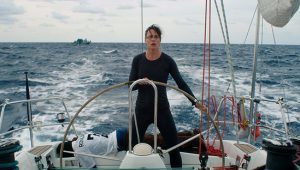
While attending to an injured African refugee (Gedion Odour Wekesa, laying on deck), physician and sailor Rieke (Susanne Wolff, standing) struggles to help those in need while awaiting help from a noticeably absent Coast Guard rescue party in “Styx.” Photo courtesy of Beta Cinema.
Based on the conversations and events here, sadly, the attitudes of officialdom are quite telling, presumably reflective of the beliefs underlying them. The authorities are only too willing to assist an affluent White European woman but unconcerned in coming to the aid of a group of Black African refugees, women and children included. Politically correct rhetoric and pronouncements aside, the actions of officials here thus speak volumes about what their real views are.
But this question is not the only issue put to the test in this situation. Rieke’s personal character is challenged by what’s unfolding around her, forcing her into addressing issues like transformation, innovation, sacrifice and salvation, both for those she’s trying to help as well as for herself. How she views the events at hand will determine her responses, which, in turn, will further alter her beliefs and what subsequently stems from them. It’s a very fluid situation as she assesses the conditions and attempts to come up with solutions for attending to them. It not only calls forth traits she already possesses, but it also pushes the emergence of others, including some of which she may have previously been unaware, enabling her to evolve in ways she may not have envisioned when she embarked on her journey. She may find that surprising. But, then, given her projected destination – Ascension Island, a locale distinguished by its own exploration of the concept of evolution – her character-testing experience with the refugees is an ironically fitting reflection of that idea where she’s concerned personally.
This is particularly noteworthy where the question of responsibility is concerned. Rieke is already well versed in this subject given her profession. However, with what she’s up against on the high seas, this notion gets pushed to a new level. In this case, her actions veer into the territory of taking a stand to make a difference, forging a safety net essentially from scratch, despite the perilous potential consequences, in light of an apathetic bureaucracy that fails to live up to its own responsibility. In doing so, she needs to surpass the limitations at hand, drumming up new solutions to suit the unparalleled circumstances she now faces.
In addition to these considerations, the film is loaded with religious symbolism fitting to the story. First there’s the title, “Styx,” a reference to the river the deceased traversed in journeying to the Underworld in Greek mythology, an appropriate symbol for a life and death situation taking place on water. From the story itself, there’s Rieke’s experience with the storm, an event that serves as her own “dark night of the soul” experience, one in which she’s tested on the resilience of her faith in herself and in the assumed support of the Universe. And then there’s Rieke’s stated destination, “Ascension” Island, a place whose name reflects the transformative nature of her journey, a designation that metaphorically embodies the divine ascendancy attained by Christ after a life of salvation and compassion toward others, acts that Rieke unhesitatingly engages in herself when circumstances warrant. These narrative enhancements aren’t intended to evangelize audiences, but they add nuance to the story, strengthening the film’s prevailing viewpoints, ultimately making for a more powerful and more meaningful picture, one worthy of the introspection it was designed to engender.

Despite some occasional pacing issues, this fact-based, richly symbolic drama sizzles with quiet intensity against the backdrop of beautiful ocean scenery. The picture’s thoughtfully constructed script leaves viewers with much to ponder, some of it inspiring, some of it unsettling, but you’re sure not to come away from this one feeling neutral. Susanne Wolff’s superb portrayal of a woman pitted against the perils of nature and the difficulty of hard choices is riveting from start to finish. Director Wolfgang Fischer’s minimalist approach suits the story perfectly, especially when enlivened by its positively gorgeous cinematography. There’s a good chance that this consuming release will leave you drained, and incensed, but also, one would hope, uplifted.
“Styx” has primarily been screening on the film festival circuit, where it has garnered numerous awards and nominations. A limited theatrical release is currently under way as well; check your local film listings and the film’s web site for details. And, by the way, those who dislike reading subtitles should note that, even though this is a German-Austrian co-production, most of the dialogue is in English.
Our ability to take the interests of others into account is often seen as one of the traits that separates us from the animals. Self-interest is assumed to be substituted by selflessness. But, as this film shows, that may not always be the case; it’s a point on which we might well fail. Thankfully, though, there are those who believe in living up to that loftier aspiration, even when the going gets tough. That’s one of those qualities that defines us as humans – and that puts the “human” in “humanity.” Let’s hope we never lose sight of that.
Copyright © 2018-19, by Brent Marchant. All rights reserved.
The post ‘Styx’ tackles morality on the high seas appeared first on Brent Marchant.



